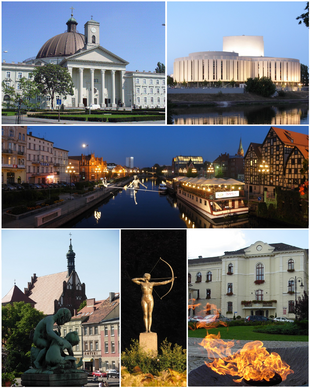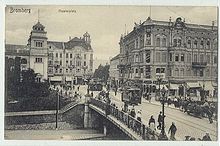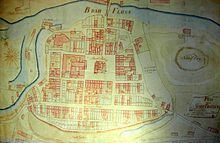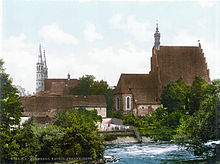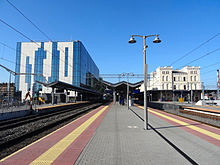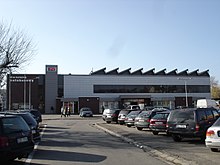Bydgoszcz
| Bydgoszcz | ||
|---|---|---|

|
|
|
| Basic data | ||
| State : | Poland | |
| Voivodeship : | Kuyavian Pomeranian | |
| Powiat : | District-free city | |
| Area : | 175.98 km² | |
| Geographic location : | 53 ° 7 ' N , 18 ° 0' E | |
| Height : | 60 m npm | |
| Residents : | 349,021 (Jun. 30, 2019) |
|
| Postal code : | 85-001 to 85-915 | |
| Telephone code : | (+48) 52 | |
| License plate : | CB | |
| Economy and Transport | ||
| Street : | DK10 Szczecin - Płońsk | |
| DK5 Gdansk - Wroclaw | ||
| DK25 Bobolice - Kalisz | ||
| Next international airport : | Bydgoszcz | |
| Gmina | ||
| Gminatype: | Borough | |
| Surface: | 175.98 km² | |
| Residents: | 349,021 (Jun. 30, 2019) |
|
| Population density : | 1983 population / km² | |
| Community number ( GUS ): | 0461011 | |
| Administration (as of 2010) | ||
| City President : | Rafał Bruski ( Citizens' Platform ) | |
| Address: | ul. Jezuicka 1 85-102 Bydgoszcz |
|
| Website : | www.bydgoszcz.pl | |
Bydgoszcz ( [ ˈbɨdgɔʃʧ ]), German Bromberg , is - next to Toruń (Thorn) - one of the two capitals of the Polish Kujawy-Pomeranian Voivodeship .
The independent city is with 349,021 inhabitants (as of June 30, 2019) the eighth largest city in Poland. More than 400,000 people live in the surrounding area, which also includes the 200,000-inhabitant city of Toruń, 45 kilometers away; the entire Bydgoszcz agglomeration has around 800,000 inhabitants.
Geographical location
Bydgoszcz is part of the historical Kuyavian landscape and is located about 235 kilometers east of Szczecin , 110 kilometers northeast of Poznan and about 150 kilometers south of Gdansk . The Brda ( German Brahe ) flowing through the center flows into the lower Vistula in the eastern part of the city . There is a connection to the west to the Warta and Oder via the Kanał Bydgoski and the Noteć .
coat of arms
Blazon : In silver, a continuous, tinned, red, black grooved wall with a blue two-winged gate and gold fittings and a gold drawn grille ; the right gate wing is open. On the wall three towers with black windows and gold knobs on blue spiers. The middle tower is the taller one and a golden flag flies to the right.
history

From the Middle Ages to 1772
The first settlement on the site of the present city was built in the 11th century. In 1238 the settlement of Duke was Swantopolk II of Pomerellen. Conquered in the Kujawy Duke Kazimierz I of Cujavia closed peace treaty, the first Bromberger is Castellan , Suzzlaus de Budegac mentioned. In 1332 the settlement was destroyed by the Teutonic Order and occupied by the Order until 1343. After the Peace of Kalisz , the Polish King Casimir the Great built a castle in its place. On April 19, 1346, the two German locators Johann Kesselhuth and Konrad were granted Magdeburg city rights by the Polish King Casimir . They received the lands west of the newly built castle (today Stary Rynek ) , and they should also bear the title of Vogt for life , which should be passed on to their descendants. In return, they should bring new settlers to the war-torn area. The city was to be named Kunigesburg in honor of the king . However, this name did not catch on. The German part of the population named the city of Brahenburg after the river Brahe , while the Polish part of the population transferred the name Bydgost to the city, which in the course of time became Bromberg and Bydgoszcz . Both names existed side by side on an equal footing for centuries.
The city was close to the border with Pomerania . Around the middle of the 13th century there was a bridge over the Brahe here, and a customs post against Pomeranians was located here.
The city arms show a red castle on a white background. Noteworthy is the rare motif of the half-open the castle gate, but which is also the emblem of Toruń ( Thorn place).
In 1550 Bydgoszcz received the privilege de non tolerandis Judaeis (privilege not to tolerate Jews) from the Polish King Sigismund II August , a ban on Jews that was lifted after the Prussian occupation in 1772 under Frederick the Great .

In the 16th century, Bydgoszcz was one of the largest cities in Poland. A Reichstag was held here in 1520. In 1657, at the time of the Second Northern War, the Treaty of Bromberg was signed here, which included a confirmation of the Treaty of Wehlau and which provided for the withdrawal of Brandenburg-Prussia from the alliance with the Kingdom of Sweden .
After destruction in the Third Northern War (the castle and the city walls were blown up by the Swedes), a flood disaster and then an epidemic, Bromberg only had around 700 inhabitants in 1772.
cartography
Although Bydgoszcz belonged to the Duchy of Pomerania-Stolp for only 94 years and to the Order of Prussia for only eleven years , the area on the lower Brahe with Bydgoszcz and Fordon in maps from the 16th to 18th centuries (until 1772) is basically as Part of Prussia or Pomerania has been drawn in, as if it had been understood as part of the latter that remained Polish from the early 14th century to 1466.
Prussian period (1772–1920)
From 1772 to 1807 Bromberg belonged to the Prussian province of West Prussia , from 1807 to 1815 to the Duchy of Warsaw and from 1815 to 1920 to the Prussian province of Posen . Right at the beginning of the Prussian period, the city experienced through the construction of the 27 km long Bromberger Canal , which today connects the Brahe with the Netze - and thus the river system of the Vistula with that of the Oder - and at the end of the 19th century through the construction of the Ostbahn an economic boom. During the Kościuszko uprising in 1794, a battle between rebels and Prussians took place near Bromberg .
The population of the city of Bydgoszcz grew to 57,700 by the 1910 census, 84 percent of them ethnic Germans and almost 16 percent ethnic Poles . A large part of the ethnically German urban population was of Protestant faith. Since the Prussian administrative reform of 1818, Bromberg had been the capital of the administrative district of the same name in the Prussian province of Posen . Because of the relatively high proportion of the Polish population in the district of Bromberg, the district's official gazette was published in two languages.
The Royal High School with a Protestant orientation was opened in 1817, and in 1851 a secondary school with an Abitur class was set up in parallel. In 1875, Bromberg left the district of Bromberg and formed its own urban district .
During the Poznan Uprising in January and February 1919, fighting broke out in front of the city between Polish insurgents and German Freikorps, including Border Guard Battalion III and the Voluntary Marined Division East . Bydgoszcz did not come under Polish administration, so the Bydgoszcz were able to participate in the election for the German National Assembly in 1919.
In the Second Polish Republic
After the end of the First World War , the largely German-speaking city was ceded to Poland in January 1920 due to the provisions of the Versailles Treaty . It was assigned to the Poznan Voivodeship .
The ethnically German population became a minority through emigration and the expropriation of German property by the Polish state. The wave of emigration was fueled by the Polish-Soviet War , as families from Bydgoszcz who opted for Polish citizenship had to expect that their sons would be drafted by the Polish state for military service in the war against the Soviet Union . Those who opted to retain German citizenship did not belong to the minority of the Poles of German ethnicity , whose members were Polish citizens with a right of residence such as compulsory military service, but became a German expatriate without safe residence in Poland. In 1925, the majority of Bydgoszcz, which now has 104,000 inhabitants, was Catholic (87%), most of whom came from Poland as citizens and ethnic groups.
Nevertheless, Bromberg always remained a center of the German minority in Posen, Netzegau and Pommerellen. Outstanding representatives of the German minority at that time were:
- Erwin Hasbach , chairman of the board since 1923, member of the Sejm in 1920 , later in the Senate until 1930.
- Kurt Graebe , CEO of a cooperative bank in Pommerellen, member of the Sejm from 1922 to 1935.
In 1934 the German Association for Poznan and Pomeranian was founded with its seat in Bromberg. On April 1, 1938, the independent city ( miasta na prawach powiatu ) came to what was then the Greater Pomerania Voivodeship ( Województwo Wielkopomorskie ) as part of a territorial reform .
Second World War to the present
After the start of the German attack on Poland , there were violent attacks on ethnic Germans in Bromberg on September 3 and 4, 1939 , in which at least 358, mostly men, were killed in the city and which the Nazi propaganda called " Bromberger Blutsonntag " were instrumentalized. The official number of victims mentioned for the whole of Poland has increased tenfold. Due to the events of the war and the exploitation of the incidents in the German press, the causes of the outbreak of violence in Bromberg as well as the number of victims remained hotly controversial between Germans and Poles. In the meantime, more differentiated investigations enable a relatively precise reconstruction of the actual processes.
After the Polish defeat, Bydgoszcz was annexed to the Reichsgau Gdansk-West Prussia of the German Empire with the occupation administrative district of Bromberg . The German Association for Poznan and Pomeranian, founded in 1934, was dissolved. The ethnically Polish inhabitants suffered from arbitrary measures, arrests, expulsions and atrocities (see also Crimes of the Wehrmacht # Poland ). As part of the Tannenberg enterprise planned before the start of the war, an estimated 1,400 to 3,000 residents of the city and its surroundings were shot dead in the so-called " Valley of Death " in Fordon near Bromberg from the end of September to the end of October 1939 by members of the Einsatzkommando 16 and the paramilitary Volksdeutscher Selbstschutz . Polish estimates even speak of up to 5,000 dead at this murder site.
Corpses of dead ethnic Germans, Bydgoszcz Blood Sunday , 1939
ethnic Polish teachers from Bydgoszcz on the way to the execution in the " Valley of Death " (November 1, 1939),
NS district leader and Lord Mayor Werner Kampe wanted to redesign the city monumentally. This failed because of the costs, but some renovation work was started. In the process, some historical buildings (including the Jesuit church that was reshaped by Karl Friedrich Schinkel ) were demolished. In October 1939, the city's Great Synagogue was destroyed.
On January 27, 1945, units of the Red Army and the Polish People's Army captured the city in the course of the Vistula-Oder operation . During the reconstruction of the "Greater Pomeranian Voivodeship", Toruń (Thorn) initially remained the capital. When the voivodeship was reduced in size on April 7, 1945, with the “large” omitted from the name, Bydgoszcz became the capital. In 1950, the voivodeship ( Województwo Pomorskie ) was renamed after the city in Województwo Bydgoskie .
The city, which was relatively little destroyed in the war - the city theater was set on fire after the conquest by Red Army soldiers - continued to grow vigorously in the following decades. Since 1947 Bydgoszcz has been the seat of the "Pomeranian Military District", which is responsible, among other things, for the defense of the northern regions of Poland in the event of war. A town partnership with Mannheim has existed since 1991 . On May 6, 1991 the "Society of the German Minority in Bromberg" was founded, which among other things works closely with the Volksbund Deutsche Kriegsgräberfürsorge . Since 2004, Bydgoszcz has been the seat of a Roman Catholic diocese and the NATO Joint Force Training Center .
- Population development
| year | number | Remarks |
|---|---|---|
| 1771 | approx. 1,000 | 80% of them are Catholics |
| 1772 | 500-600 | , all Catholics |
| 1780 | 2,046 | without the military |
| 1783 | 2,562 | without the military, including 27 Jews |
| 1788 | 3,077 | without the military |
| 1792 | 3,915 | without the military |
| 1816 | 6.123 | 3,325 Lutherans, 2,522 Catholics, 223 Jews, 53 Reformed |
| 1852 | 12,900 | mostly Germans, 26% of them Catholics |
| 1875 | 31,308 | |
| 1880 | 34,044 | |
| 1885 | 36,294 | |
| 1890 | 41,399 | thereof 28,411 Evangelicals, 11,165 Catholics, 1,451 Jews and 372 others |
| 1900 | 52.204 | thereof 34,415 Evangelicals, 15,662 Catholics and 2,127 others including Jews |
| 1910 | 57,696 | of which 37,008 Protestants, 18,539 Catholics and 2,149 others including Jews (84% Germans, almost 16% Poles) |
| 1921 | 88,000 | including 64,000 Catholics and 22,500 Evangelicals (24,000 Germans, the number of which had fallen to almost half by 1928) |
| 1941 | 144.252 | |
| 2012 | 362.286 |
Monuments erected before 1918 but not preserved
- Emperor Friedrich III. - Bust monument in the barracks area of the (2nd Pomeranian) field artillery regiment No. 17; unveiled on September 16, 1888; eliminated after 1920
- Kaiser Wilhelm I - Bust monument in the barracks area of the (2nd Pomeranian) field artillery regiment No. 17; unveiled on September 16, 1888; eliminated after 1920
- Bust of the politician Franz Balthasar Schönberg von Brenkenhoff on the Bromberg Canal; unveiled on October 27, 1894; lost
- The monument was a foundation of the Historical Society for the Networks District.
- District war memorial for those who fell in the wars of unification in 1864, 1866 and 1870/71 on the seminar square; eliminated after 1920
- The war memorial consisted of a base, the four corners of which were held by small columns. On the cornice of the plinth stood four eagles with bronze garlands in their beaks. On the pedestal rose an obelisk crowned with the Iron Cross .
-
Grave monument Theodor Gottlieb von Hippel (* 1775 † 1843) in the city cemetery
- On an obelisk, which was decorated with an iron cross and a laurel festoon, there was a bronze relief medallion of the writer who wrote the later famous appeal “ To my people ”.
-
Bismarck Tower on Bismarck-Höhe on the Brda , built according to a design by Berlin architect Paul Walther , inauguration on May 25, 1913
- In October 1923, the Bismarck Tower was rededicated to the freedom tower by a resolution of the city council and made available to the Catholic community as a chapel . Conversions failed due to lack of funds, so that finally the demolition of the tower was considered. The first attempt to blow up the tower failed on May 16, 1928. On May 18, 1928 it was finally blown up. Only the outside staircase that today leads to the so-called freedom hill is preserved.
- Inside the tower was a Bismarck statue by the Berlin sculptor Fritz Richter-Elsner . The statue was brought to Frankfurt (Oder) as early as 1919 and erected there as an independent memorial.
- Kaiser Wilhelm II. - Still picture on the facade of the corner building Theaterplatz / Hermann-Francke- Strasse at the height of the 2nd floor ; not received
- Bronze statue of King Frederick the Great in the stairwell of the regional council; melted down
- Equestrian statue of Kaiser Wilhelm I by the Berlin sculptor Alexander Calandrelli , unveiled on September 17, 1893, bronze cast by the Schäffer & Walcker fine art foundry in Berlin ; the total cost of the monument amounted to 75,000 marks
- After the effects of the Versailles Treaty were known, the monument on 15 July 1919 before taking over the city, degraded by the Poland and the neighboring could Meseritz translocated be where it remained until 1946th
- Statue of King Frederick the Great, by sculptor Eduard Uhlenhuth
- Celebration of the laying of the foundation stone on October 21, 1861 in the presence of King Wilhelm I, who was on his way back from his coronation in Königsberg , on Friedrichsplatz. On May 31, 1862, the monument was ceremoniously unveiled in the presence of Crown Prince Friedrich Wilhelm .
- On July 15, 1919, the monument was dismantled and recovered, and it was erected on June 1, 1923 on the Küddow Bridge in Schneidemühl . After the beginning of the Second World War, the monument in Schneidemühl was dismantled in September 1939 and re-erected on April 21, 1941 on the edge of Friedrichsplatz in front of the building of the former Chamber Deputation . The memorial has been lost since 1945.
Labor camp in World War II
- The "external labor camp Bromberg-Ost" was a satellite camp of the Stutthof concentration camp for women and was opened on September 12, 1944. The labor camp supervisor was Johanna Wisotzki , and the well-known guards included Ewa Paradies and Gerda Steinhoff . The approximately 300 women held captive in the camp were used to load the trains at the Bromberg-Ost train station.
- The “external labor camp Bromberg-Brahnau” was also part of the Stutthof concentration camp . It was opened on July 15, 1944. Approx. 6,000 forced laborers from Dynamit AG Bromberg were interned in the camp. Most of them were Soviet, Yugoslav, Italian and French prisoners of war and 2500 women. The inmates of the camp were liberated by the Red Army on January 28, 1945 . Until June 1945 there was a satellite camp of the Central Labor Camp Potulice in the buildings , in which 1,500 Germans were detained. Brahnau is now part of the Bydgoszcz-Łęgnowo district .
Secret missile launcher
In the forests of the district Osowa Góra (Hoheneiche) which was during the Second World War air munitions plant 1 / II Bromberg (Luftmuna) built. Only Germans had access to the Luftmuna. In the second half of 1944, cruise missiles of the type V1 were shot down here for experimental purposes . In 1945 the plant was dismantled by the Soviets and relocated to the Soviet Union . Today there are only three huge bunkers with a depth of three and a half meters on the site. Civilians are still prohibited from entering the site.
Incorporations
| year | local community | size | Today's part of town |
|---|---|---|---|
| 1851 | Brenkenhof dismantling, Żupy | 80 ha | Bocianowo ( Brenkenhof ),? |
| 1867 | Brenkenhof Forsthaus, Hempels Feld | 265 ha | Bocianowo ( Brenkenhof ), Grodztwo |
| 1876 | Ludwigshof, Neuhof | 283 ha | Ludwikowo ( Ludwigshof ),? |
| 1907 | Part of Bleichfelde and Schwedenhöhe | 42 ha | Bielawy ( Bleichfelde ), Szwederowo ( Schwedenhöhe ) |
| 1920 | Remainder of Bleichfelde and Schwedenhöhe, Groß Bartelsee, Klein Bartelsee, Kaltwasser, Fordonek, German Fordon, Brahnau, Schöndorf , Jägerhof , Jagdschűtz, Prinzenthal, Schleusendorf, Schleusenau, Schröttersdorf , Neu Beelitz | 5793 ha | Bielawy ( bleach field ) Szwederowo ( Sweden height ), Bartodzieje ( Bart Staffelsee ) Wyżyny, Zimne Vody ( cold water ), Brdyujście, Siernieczek, Łęgnowo, Rupienica ( Schöndorf , today Wzgórze Wolności), Czyżkówko ( Jaegerhof ) Jachcice ( hunting contactor ) Wilczak ( Prinzenthal ), Jary, Miedzyń ( Schleusendorf ), Okole ( Schleusenau ), Skrzetusko ( Schröttersdorf ), Bielice ( Neu Beelitz ) |
| 1954 | Opławiec, Prądy (formerly Prondy), Żółwin | 4340 ha | Opławiec, Prądy, Żółwin |
| 1959 | Osowa Góra ( High Oak ) | 512 ha | Osowa Góra ( High Oak ) |
| 1961 | Janowo | 489 ha | Janowo |
| 1973 | Fordon | 830 ha | Fordon |
| 1977 | Part of Osielsko, Czarnówczyn, Łoskoń, Smukała Dolna, Łęgnowo ( Langenau ), Plątnowo, Mariampol ( Marienfelde ), part of Wypaleniska ( Feyerland ), Myślęcinek, Niemcz | 4639 ha | Osielsko, Czarnówczyn, Łoskoń, Smukała Dolna, Łęgnowo, Plątnowo, Mariampol, Wypaleniska, Myślęcinek, Niemcz |
politics
City President
A city president is at the head of the administration . Since 2010 this has been Rafał Bruski from Platforma Obywatelska . The 2018 election led to the following result:
- Rafał Bruski ( Koalicja Obywatelska ) 54.6% of the vote
- Tomasz Latos ( Prawo i Sprawiedliwość ) 29.6% of the vote
- Marcin Sypniewski (independent) 6.2 & the vote
- Anna Mackiewicz ( Sojusz Lewicy Demokratycznej / Lewica Razem ) 6.1% of the vote
- Paweł Skutecki ( Kukiz'15 ) 3.5% of the vote
Bruski was re-elected in the first ballot.
City council
The city council consists of 31 members and is directly elected. The 2018 city council election led to the following result:
- Koalicja Obywatelska (KO) 42.6% of the vote, 16 seats
- Prawo i Sprawiedliwość (PiS) 29.3% of the vote, 11 seats
- Sojusz Lewicy Demokratycznej (SLD) / Lewica Razem (LR) 14.4% of the vote, 4 seats
- Election Committee Bydgoszcz 2018 6.1% of the vote, no seat
- Kukiz'15 5.9% of the vote, no seat
- Remaining 1.7% of the vote, no seat
Town twinning
-
 Cherkassy , Ukraine
Cherkassy , Ukraine
-
 Hartford , USA
Hartford , USA
-
 Kragujevac , Serbia
Kragujevac , Serbia
-
 Kremenchuk , Ukraine
Kremenchuk , Ukraine
-
 Mannheim , Germany
Mannheim , Germany
-
 Ningbo , People's Republic of China
Ningbo , People's Republic of China
-
 Pavlodar , Kazakhstan
Pavlodar , Kazakhstan
-
 Patras , Greece
Patras , Greece
-
 Perth , Scotland
Perth , Scotland
-
 Reggio nell'Emilia , Italy
Reggio nell'Emilia , Italy
-
 Tempe , USA
Tempe , USA
-
 Wilhelmshaven , Germany
Wilhelmshaven , Germany
Attractions
Old town
- Roman Catholic Cathedral of St. Martini and Nikolai , 1466–1502, late Gothic
- Church of the Queen of Peace St. Marien , built 1552–1557, late Gothic, 1860–1945 garrison church
- Church of the Assumption of Mary , 1582–1602, Poor Clares, Capuchins
- Herz-Jesu-Kirche, 1910–1913, neo-baroque
- Wenecja Bydgoska , the “Bydgoszcz Venice”, a district on the water
- Half-timbered storage houses
- Mill Island
- Mill (built 1851)
- historical mint (formerly the only one in Poland)
- Houses from the 18th / 19th century Century
- Half-timbered storage houses from the 19th / 20th centuries Century
- White warehouse (built 1780)
- Red warehouse
Suburbs
- the parish cemetery from 1806 with graves of French prisoners of war of the Franco-German War
- Protestant St. Paul's Church (built 1872–1876), on Danziger Strasse ( today: Roman Catholic Apostle Church)
- Evangelical Augsburg Church of the Redeemer (built in 1896)
- Water tower (built 1900)
- New Evangelical Parish Church (built 1900–1903) (today: Andrzej Boboli Church of the Jesuits)
- the deluge fountain (1904)
- a weir on the Brahe (built 1904–1906)
- Bromberger Canal (1773/74, modernized 1914–1917) with numerous locks and water weirs
- neoclassical St. Vincent Basilica (built 1925–1937)
- “Sielanka” villa district, with villas from the beginning of the 20th century, based on plans by Josef Stübben
- the open-air museum on the western outskirts with remains of Polish defenses from September 1939
- Exploseum , ruins of the DAG factory in Bromberg
Fordon
- Nikolaikirche (Fordon) , today's building 1691
- rest of the old town of Fordon
Myślęcinek
- the nature and health resort on the outskirts with a cultural and recreational park
Surrounding area
- the village of Ostromecko on the opposite bank of the Vistula, with its castles
Museums
- Muzeum Okręgowe im. Leona Wyczółkowskiego (Regional Museum)
- Muzeum Kanału Bydgoskiego (Museum of the Bydgoszcz Canal)
- Muzeum Wojsk Lądowych (Army Museum)
- Izba Tradycji Bydgoskich Dróg Żelaznych (Traditional House of the Bydgoszcz Railway)
- Muzeum Dyplomacji i Uchodźstwa Polskiego (Museum of Diplomacy and Emigration)
- Muzeum Farmacji przy Aptece "Pod Łabędziem" (Pharmaceutical Museum)
- Muzeum Wodociągów w Bydgoszczy ( Aqueduct Museum)
theatre
- Teatr Polski w Bydgoszczy (Polish Theater)
music
Bydgoszcz is one of the most important music centers in Poland:
- Opera Nova , as an institution since 1956, the opera house opened in 1974. The city's only Polish opera festival takes place every year.
- Filharmonia Pomorska , valued for its excellent acoustics
Regular events
- International Paderewski Competition for Pianists
- Bromberg Opera Festival
- Camera Obscura - Documentary Film Festival
- Camerimage - film festival with a focus on cameras
- Grand Prix race of the Speedway Individual World Championship
- Brda Cup rowing regatta
- Pedro's Cup - International Indoor Athletics Meeting
Sports
Before 1920 the Germans dominated sports life in Bydgoszcz. In 1894 they founded the Frithjof rowing club and a short time later the men's gymnastics club and the tennis club Palästra. As football grew in popularity, they founded the Association for Football and Athletics Sports Club Bromberg . The Polish population had the Sokół gymnastics society since the 1880s . In 1918 young Polish workers founded the Society of Journeyman, which later became the Gwiazda Sports Club . After Bromberg came to Poland in 1920, the Tryton rowing company was founded, which over time became the BTW Bydgoszcz rowing club . The German clubs continued to exist in the now Polish city of Bydgoszcz. In 1999 the first IAAF World Athletics Championships (U18) took place in Bydgoszcz , the World Junior Athletics Championships in 2008 and the 38th World Cross Country Championships in 2010 . In 2019 the Super League competitions of the European Athletics Team Championship took place in Bydgoszcz.
Important sports clubs from Bydgoszcz today are:
- Astoria Bydgoszcz - basketball
- Zawisza Bydgoszcz - football , athletics
- Polonia Bydgoszcz - speedway , football
- Pałac Bydgoszcz - Volleyball Women
- Bydgostia Bydgoszcz - rowing
- Artego Bydgoszcz - women's basketball
- Chemik Bydgoszcz - men's volleyball , football
- BKS Bydgoszcz - football , ice hockey , chess
- Gwiazda Bydgoszcz - table tennis , football , wrestling
Former German sports clubs
- Rowing club Frithjof Bromberg - (bronze in the double scull men championship 1940)
- Bromberg rowing club
- Men's gymnastics club Bromberg
- Men's gymnastics club Schleusenau
- Bydgoszcz gymnastics club
- Gymnastics Club Friesen Bromberg
- Gymnastics Club Hohenzollern in Schwedenhöhe
- Gymnastics Club Jahn Bromberg
- Sportbrüder Bromberg - football, athletics, tennis
- SC Bromberg - football, athletics, tennis, ice skating
- Palaestra Bromberg - tennis
- Bydgoszcz Touring Club - cycling
- Athletics and ring sports club Bromberg
- Bromberg-Schneidemühler riding club
- Bromberger Verein für Luftschifffahrt
- Bydgoszcz Anglers Club
During the Second World War:
- SG Bromberg - football, handball, athletics, basketball, small-bore shooting, boxing
- Luftwaffen-SV Bromberg - football
- Wehrmacht-SV Bromberg - football
- Reichsbahn SG Bromberg - football, handball
- Post SG Bromberg - football
- SG Ordnungspolizei Bromberg - football
language
Economy and Infrastructure
Bydgoszcz is one of the largest Polish cities, an important industrial and commercial center in an intensely agricultural area, and is conveniently located as a traffic junction.
In the past the city was called "little Berlin". The city has retained much of its old charm because of the many waterways and the existing Art Nouveau architecture.
traffic
The city has its own international airport, Ignacy Jan Paderewski Airport Bydgoszcz . From here, three airlines offer direct flights to Warsaw, London, Dublin, Liverpool, Frankfurt and charter flights to Tunisia and Turkey.
Important train stations are:
- Bydgoszcz Główna - Central Railway Station
- Bydgoszcz Leśna
- Bydgoszcz Wschód
- Bydgoszcz Zachód
- Bydgoszcz Łęgnowo
- Bydgoszcz Bielawy
- Bydgoszcz Osowa Góra
- Bydgoszcz Błonie
The city has a tram network of 63.5 kilometers. The main bus station is PKS Bydgoszcz, from which over 80 destinations across Poland can be reached.
For ferry traffic, see Bydgoszcz water taxi . There is an inland water connection between the city and Berlin through the Brda, Kanał Bydgoski, the Netze and the Oder. However, the waterway is waiting to be revitalized and used economically.
In December 2013 the university city passage was opened, which connects the northern and southern parts of the city with the university bridge over the Brda . The cable-stayed bridge has two architecturally strikingly designed intertwined pylons .
Established businesses
- Atos - French IT service provider
- PESA - rail vehicles
- GlobalMalt Polska - malt factory
- Wojskowe Zakłady Lotnicze nr 2 SA (Military Repair Company No. 2) - repair of Polish fighter jets and passenger planes
- Frosta
Former German companies
- Dynamit AG
- "Elch" wood and upholstery factory Lehr & Co. KG
education
Bydgoszcz is a university town ( Casimir the Great University , Technical University, Conservatory, Collegium Medicum).
There is a large number of universities in Bydgoszcz
- Uniwersytet Kazimierza Wielkiego formerly Akademia Bydgoska im. Kazimierza Wielkiego
- Agricultural University (Uniwersytet Technologiczno-Przyrodniczy im. Jana i Jędrzeja Śniadeckich) formerly Akademia Techniczno-Rolnicza im. Jana i Jędrzeja Śniadeckich
- Music Academy (Akademia Muzyczna)
- Collegium Medicum im. Ludwika Rydygiera from the University of Toruń
- Branch of the Academy of Economics (Akademia Ekonomiczna) in Poznań
- Branch of the theology department of the Adam Mickiewicz University in Poznań
- Kujawsko-Pomorska Szkoła Wyższa University of Applied Sciences
- University of Applied Sciences for Economics (Wyższa Szkoła Gospodarki)
- University of Applied Sciences for Computer Science and Law (Wyższa Szkoła Informatyki i Nauk Społeczno-Prawnych)
- University of Applied Sciences for the Environment (Wyższa Szkoła Środowiska)
- University of Applied Sciences for Public Administration and Finance (Wyższa Szkoła Zarządzania i Finansów)
- Branch of the University of Applied Sciences for Computer Science (Wyższa Szkoła Informatyki) in Łódź
Personalities
→ Main article: List of personalities of the city of Bydgoszcz
The city made the personalities Edward Rydz-Śmigły , John Paul II and Irena Szewińska honorary citizens. Famous sons and daughters of Bydgoszcz include the officer Max von Boehn , the neurologist Louis Jacobsohn-Lask , the mathematician and cryptologist Marian Rejewski , the South Sea explorer, circumnavigator and Vice Admiral Georg von Schleinitz as well as the Polish Prime Minister Jan Bielecki and erotic star Vivian Schmitti .
literature
- Ludwig Kühnast : Historical news about the city of Bromberg - From the foundation of the city to the Prussian occupation . Ernst Siegfried Mittler , Bromberg / Berlin / Posen 1837 ( digitized version of the Bavarian State Library).
- Johann Friedrich Goldbeck : Complete topography of the Kingdom of Prussia. Second part, which contains the topography of West Prussia . Kantersche Hofdruckerei, Marienwerder 1789, pp. 82–83, No. 1.) in the Google book search
- Heinrich Wuttke : City book of the country Posen. Codex diplomaticus: General history of the cities in the region of Poznan. Historical news from 149 individual cities . Hermann Fries, Leipzig 1864, pp. 274–286. in Google Book Search
- Frieder Monzer: Posen, Thorn, Bromberg. With Greater Poland, Kuyavia and Southeast Pomerania . Trescher, Berlin 2012, ISBN 978-3-89794-201-1 .
- Alfred Cohn: Memories of Bromberg = Wspomnienia o Bydgoszczy . Toruń: A. Marszalek, 2001 ISBN 83-7322-103-4
Web links
- General
- Official site (multilingual)
- Official site VisitBydgoszcz
- More website about the city
- History of the city of Bydgoszcz
- Michael Rademacher: German administrative history from the unification of the empire in 1871 to the reunification in 1990. Province of Posen - city district of Bromberg. (Online material for the dissertation, Osnabrück 2006).
- German-language publications about Bydgoszcz / Bromberg at LitDok East Central Europe / Herder Institute (Marburg)
- panorama
- Bydgoszcz on old maps
- Map by Caspar Henneberg , circa 1550, Pomerania, Marca (Brandenburg), Prussia (western part with Danzig )
Individual evidence
- ↑ a b population. Size and Structure by Territorial Division. As of June 30, 2019. Główny Urząd Statystyczny (GUS) (PDF files; 0.99 MiB), accessed December 24, 2019 .
- ^ City website, Prezydent Miasta , accessed February 11, 2015.
- ^ Heinrich Gottfried Philipp Gengler : Regesta and documents on the constitutional and legal history of German cities in the Middle Ages , Erlangen 1863, p. 403 ff. In the Google book search and p. 976. in the Google book search
- ^ Heinrich Wuttke : City book of the country of Posen. Codex diplomaticus: General history of the cities in the region of Poznan. Historical news from 149 individual cities . Hermann Fries, Leipzig 1864, p. 275. in the Google book search
- ^ Heinrich Wuttke : City book of the country of Posen. Codex diplomaticus: General history of the cities in the region of Poznan. Historical news from 149 individual cities . Hermann Fries, Leipzig 1864, p. 277. in the Google book search
- ↑ ACA Friederich: Historical-geographical representation of old and new Poland . Berlin 1839, p. 102. in the Google book search
- ↑ Compare e.g. B. Official Gazette of the District of Bydgoszcz, May 23, 1845. in the Google book search
- ^ Official Journal of the Royal Prussian Government in Bromberg 1875, p. 205
- ↑ a b c d e f g Michael Rademacher: German administrative history from the unification of the empire in 1871 to the reunification in 1990. Province of Posen - city district of Bromberg. (Online material for the dissertation, Osnabrück 2006).
- ^ Second World War: What Happened on the Bydgoszcz Blood Sunday. In: The world . April 18, 2012.
- ^ Jürgen Matthäus , Jochen Böhler , Klaus-Michael Mallmann : War, Pacification, and Mass Murder 1939. The Einsatzgruppen in Poland. (= Documenting Life and Destruction. Holocaust Sources in Context. Volume 7). Rowman & Littlefield, Lanham MD 2014, ISBN 978-1-4422-3142-9 , pos. 73.
- ^ Dieter Schenk: Albert Forster. Gdański namiestnik Hitlera. Wydawnictwo Oskar, Gdańsk 2002. See also Jochen Böhler The attack. Germany's war against Poland. 2009, pp. 131-140.
- ^ A b c Heinrich Wuttke : City book of the country of Posen. Codex diplomaticus: General history of the cities in the region of Poznan. Historical news from 149 individual cities . Hermann Fries, Leipzig 1864, p. 282. in the Google book search
- ^ A b c Johann Friedrich Goldbeck : Complete topography of the Kingdom of Prussia . Part II, Marienwerder 1789, pp. 82-83. in Google Book Search
- ^ August Eduard Preuss : Prussian country and folklore . Königsberg 1835, pp. 581–382 in the Google book search.
- ↑ a b August Karl von Holsche : The network district, a contribution to the country and ethnology with statistical news . Königsberg 1793, p. 111 in the Google book search.
- ↑ The Big Brockhaus. 15th edition. Volume 3, Leipzig 1929, p. 366.
- ↑ Figures in Territorial.de.
- ^ Result on the website of the Election Commission, accessed on July 21, 2020.
- ^ Result on the website of the Election Commission, accessed on July 21, 2020.
- ↑ Poland Travel: Garrison Church of St. Mary - Queen of Peace in Bromberg

